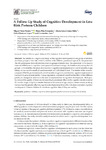| dc.contributor.author | Pérez-Pereira, Miguel | |
| dc.contributor.author | Fernández, María Pilar | |
| dc.contributor.author | Gómez-Taibo, María-Luísa | |
| dc.contributor.author | Martínez-López, Zeltia | |
| dc.contributor.author | Arce, Constantino | |
| dc.date.accessioned | 2020-04-22T11:36:30Z | |
| dc.date.available | 2020-04-22T11:36:30Z | |
| dc.date.issued | 2020 | |
| dc.identifier.citation | Pérez-Pereira, M., Fernández, M. P., Gómez-Taibo, M. L., Martínez-López, Z., & Arce, C. (2020). A Follow-Up Study of Cognitive Development in Low Risk Preterm Children. International Journal of Environmental Research and Public Health, 17(7). https://doi.org/10.3390/ijerph17072380 | es_ES |
| dc.identifier.uri | http://hdl.handle.net/2183/25394 | |
| dc.description.abstract | [Abstract] The results of a longitudinal study on the cognitive development of one group of full-term and three groups of low risk preterm children with different gestational ages (GA) are presented. The 181 participants were divided into four GA groups of similar size. The aims were: 1) To check if there are differences in cognitive development (measured through the Batelle scale) among the GA groups. 2) To establish the predictive factors of cognitive development at 22 and 60 months of age, taking into account biomedical, environmental and individual factors. The results of the repeated measures ANOVA performed at 22 and 60 months of age indicated that the cognitive trajectories of the four GA groups were similar. Linear regression analyses showed that the effect of the different predictors changed in relation to the time of measurement of cognitive development. Biological factors and the quality of home environment had a moderate effect on the cognitive development at 22 months of age. Cognitive results obtained at 22 months of age, and, to a lesser extent, working memory had the greatest effect on cognitive development at 60 months. GA does not predict cognitive development. Preterm children do not show cognitive delay if they are healthy. | es_ES |
| dc.description.sponsorship | This research was funded by the Ministerio de Ciencia e Innovación of the Spanish Government, grants number PSI2008-03905, PSI2011-23210 and PSI2015-66697-R to the first author | es_ES |
| dc.language.iso | eng | es_ES |
| dc.relation | info:eu-repo/grantAgreement/MICINN/Plan Nacional de I+D+i 2008-2011/PSI2008-03905/ES/DESARROLLO DEL LENGUAJE EN NIÑOS PREMATUROS. CURSO EVOLUTIVO Y FACTORES CONDICIONANTES/ | |
| dc.relation | info:eu-repo/grantAgreement/MICINN/Plan Nacional de I+D+i 2008-2011/PSI2011-23210/ES/DESARROLLO DEL LENGUAJE Y FACTORES RELACIONADOS EN NIÑOS PREMATUROS DE EDAD PREESCOLAR/ | |
| dc.relation | info:eu-repo/grantAgreement/MINECO/Plan Estatal de Investigación Científica y Técnica y de Innovación 2013-2016/PSI2015-66697-R/ES/DIFERENCIAS ENTRE NIÑOS PREMATUROS DE BAJO RIESGO Y NACIDOS A TERMINO EN LECTO-ESCRITURA Y HABILIDADES COGNITIVO-LINGUISTICAS/ | |
| dc.relation.uri | https://doi.org/10.3390/ijerph17072380 | es_ES |
| dc.rights | Atribución 4.0 Internacional | es_ES |
| dc.rights.uri | http://creativecommons.org/licenses/by/4.0/ | * |
| dc.subject | Preterm children | es_ES |
| dc.subject | Cognitive development | es_ES |
| dc.subject | Predictive factors | es_ES |
| dc.subject | Longitudinal study | es_ES |
| dc.title | A Follow-Up Study of Cognitive Development in Low Risk Preterm Children | es_ES |
| dc.type | info:eu-repo/semantics/article | es_ES |
| dc.rights.access | info:eu-repo/semantics/openAccess | es_ES |
| UDC.journalTitle | Environmental Research and Public Health | es_ES |
| UDC.volume | 17 | es_ES |
| UDC.issue | 7 | es_ES |
| UDC.startPage | 1 | es_ES |
| UDC.endPage | 13 | es_ES |
| dc.identifier.doi | 10.3390/ijerph17072380 | |






